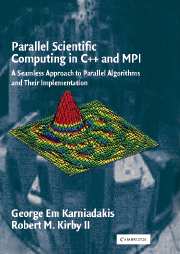
-
Select format
-
- Publisher:
- Cambridge University Press
- Publication date:
- October 2013
- June 2003
- ISBN:
- 9780511812583
- 9780521520805
- Dimensions:
- Weight & Pages:
- Dimensions:
- (240 x 215 mm)
- Weight & Pages:
- 1.07kg, 630 Pages
You may already have access via personal or institutional login
Book description
Numerical algorithms, modern programming techniques, and parallel computing are often taught serially across different courses and different textbooks. The need to integrate concepts and tools usually comes only in employment or in research - after the courses are concluded - forcing the student to synthesise what is perceived to be three independent subfields into one. This book provides a seamless approach to stimulate the student simultaneously through the eyes of multiple disciplines, leading to enhanced understanding of scientific computing as a whole. The book includes both basic as well as advanced topics and places equal emphasis on the discretization of partial differential equations and on solvers. Some of the advanced topics include wavelets, high-order methods, non-symmetric systems, and parallelization of sparse systems. The material covered is suited to students from engineering, computer science, physics and mathematics.
Reviews
‘This book is a valuable addition to the literature on numerical algorithms.’
Source: Numerical Algorithms
'There is plenty of material for a two-semester sequence, or selected chapters could be used for a one-semester course on numerical linear algebra. The presentation is clear, practical, and lively … this text would be a very useful reference for statistics students and professionals) seeking to take their statistical computing skills into the parallel realm.'
Source: Journal of the American Statistical Association
Contents
Metrics
Altmetric attention score
Full text views
Full text views help Loading metrics...
Loading metrics...
* Views captured on Cambridge Core between #date#. This data will be updated every 24 hours.
Usage data cannot currently be displayed.
Accessibility standard: Unknown
Why this information is here
This section outlines the accessibility features of this content - including support for screen readers, full keyboard navigation and high-contrast display options. This may not be relevant for you.
Accessibility Information
Accessibility compliance for the PDF of this book is currently unknown and may be updated in the future.


